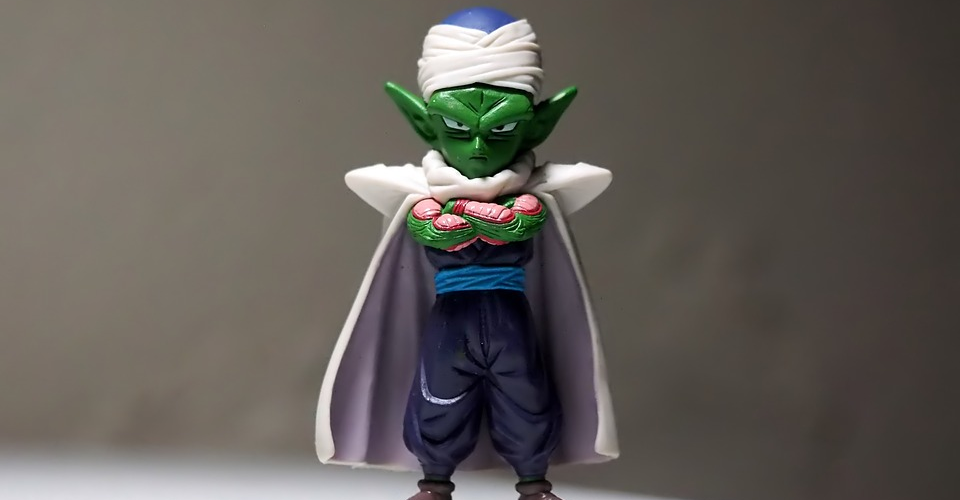All About 3D Printing Figurines and Miniatures
Design freedom is one of the biggest selling points of 3D printing. With just a few conditions, just about anything you can design on a CAD platform can be reproduced in a 3D printer. This is great news for those who are into science fiction, movies, TV shows, and video games primarily because of one thing – with a 3D printer, you can make your own action figures, figurines, and miniatures.
In this article, we take a look at the best printer settings for printing your own figurines and miniatures. We’ll also give a rundown of some of the best 3D models you can download to satisfy your inner geek.
How to print figurines and miniatures
When it comes to printing figurines, the most important factor to consider is the accuracy of details and dimensions. A good 3D model based on a popular character will likely have a lot of fine details. If you’re working with an FDM printer, then you probably already know that printing small details is something that FDM technology struggles with. This does not mean that it’s impossible. Here are a few tips to keep in mind when you start printing figurines and miniatures:
Use a small nozzle for small layer heights
The easiest upgrade you can make to your printer to create more finely detailed prints is to replace your 0.4-mm stock nozzle with a smaller one. Stepping down to 0.25 mm means that you can also set your layer heights smaller, allowing you to recreate finer details along the y-axis.
Print slow
Not only are you going to stretch your printing time because of a smaller nozzle, but you’ll also need to print a little slower than usual – anywhere between 20 to 30 mm/s. When it comes to miniatures, slow and steady wins the race.
The reason for printing slow is that you want the molten filament to cool down and solidify as quickly as possible. This allows them to develop strength quickly and retain good accuracy of features.
Use a cooling fan
This pointer is pretty obvious. As with a slow printing speed, you will want to turn on the cooling fan so that the filament material can cool quickly. This helps develop strength, preserving the dimensions and details of the reference model.
Use minimal supports
Minimal supports, necessary as they may be, can be a huge headache. This goes doubly so for very small figurines and miniatures. If your slicer software can create tree supports, then that would be a good middle ground option that provides stability without being too difficult to remove.
If you don’t have a dual extruder 3D printer, then it would be best to have as few support structures as possible. Removing supports after printing is a difficult process that can end up ruining the rest of the finished work, especially for highly detailed models.
These tips are simply general guidelines for you to follow as you set up your 3D printer for a figurine. Specific numbers may vary based on how big or detailed your model is but the underlying principle should be the same – print slow and cold.
Top 7 free 3D models for figurines and miniatures
To get your skills up to scratch, here are some free models we suggest that you practice on. None of these are exceptionally complicated but they are all pretty fun projects. If you’ve got your 3D printer ready, then why don’t you try one of these over the next weekend?
1. Batman
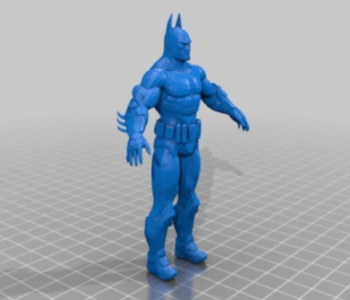
Who better to start off this list than Batman? Everybody knows who Batman is. If you aren’t into the Dark Knight, then you can probably give the finished product as a gift to someone who would be ecstatic over it.
This Batman model is a good place to start because it’s relatively simple. The whole model prints in one piece and is oriented horizontally for better stability and to minimize support structures. It’s not intricately detailed save for the belt, gauntlets, and boots, so you should be able to get impressive results by following the basic settings we have outlined above.
There’s on glaring detail that this model missed – the bat emblem on his chest. With the proper printer settings and some post-processing, this bootleg Batman doesn’t look all that bad.
2. Pikachu
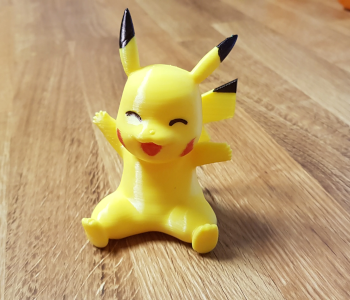
If you’re a Pokemon fan, then you’re definitely spoiled for choices when it comes to free 3D models for these critters. There are probably thousands of them out there, with most of them created after the image of the usual suspects – the starter Pokemons, the most popular ones, and the perennial hero of the franchise, Pikachu.
This Pikachu is a project that’s fairly simple to print but produces a very good result. The focus of this model is not so much the accuracy of the details but creating the illusion of a smooth and curved surface. Using a very small layer height goes a long way towards achieving this goal, although some smoothing and polishing are still recommended.
Pikachu has a pretty rotund figure, so you can print this model with as little as 20% infill. It also doesn’t require any supports. Overall, this is a figure you can simply have fun with. Sand it afterward, paint it with Pikachu’s signature colors, and no one’s going to be the wiser that this was a low-effort project.
3. The Mandalorian
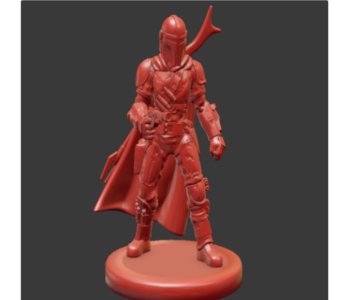
The new Mandalorian series kick-started new interest in the Star Wars franchise. Although Baby Yoda became the surprise highlight of the show, we thought that it would be more challenging to 3D print a figure of the man himself – the Mandalorian.
As anyone who has seen the character can tell you, the Mandalorian has a kick-ass intricate design. Between the Beskar armor, the flowing cape, and the signature helmet, there are a lot of small details in the Mandalorian’s character design which could be quite challenging to replicate with an FDM printer. The model comes in two flavors – one holding a rifle, and another holding a standard blaster.
You’ll have to bring your A-game with this design. Despite the level of detail, this figure was designed to be printed small – just two or three inches high. This emphasizes the importance of dialing in the right parameter, as well as using a filament that will not easily warp. The effort is worth it if you can get it right, as this mini figure looks really good.
4. Mario
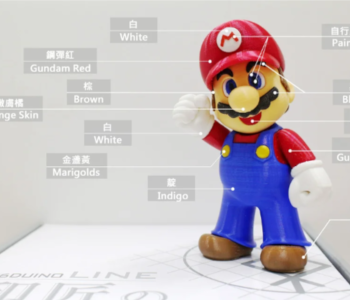
How about a shot of nostalgia to liven up the 3D printing experience? This model in the likeness of the world’s most popular plumber is going to be a massive undertaking because it’s made of 19 separate and interlocking pieces.
There are two advantages to this piece-wise approach. The first is that you can scale up the model, even if your printer has a limited build size. The second is that you can create your Mario figure using different filament colors even if you don’t have a dual extruder setup.
This Mario model taking figurine-making to the next level. If you decide to work on this, it will likely take up the better part of the week just to 3D print the individual pieces. With a bit of post-processing, the finished product of this project is something you can certainly be proud of.
5. Bojack Horseman
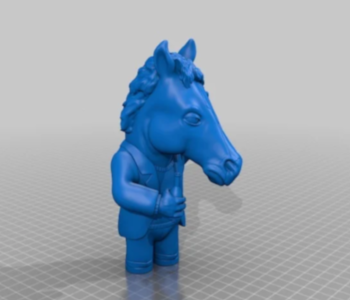
The series featuring our favorite washed-up celebrity horse may have come and gone, but how about 3D printing something to remember Bojack Horseman with? This figurine captures the disappointment, frustration, and poor life choices of Bojack and really drive home how time in the limelight can mess you up.
Bojack’s signature coat and sweater get-up aren’t very demanding when it comes to detail, but there’s one element of this model that is particularly challenging – his oversized head. Bojack’s head is so much longer and wider than his body, which means that you’ll most definitely need liberal use of support structures. Given how important his head is, removing the supports will require a firm but delicate touch.
The Bojack Horseman figure is a simple model that you can work on in just a few hours. The model captures our beloved character looking downtrodden and endearing all at the same time. Just be careful with those supports – you don’t want to end up clipping Bojack’s chin.
6. Cloud Strife
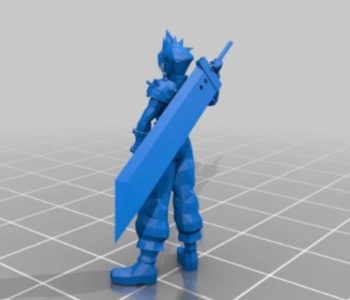
Possibly the most popular character of the modern gaming era, ex-SHINRA soldier and all-around badass Cloud Strife stands tall and proud in this amazing model. The model is heavily based on Cloud’s appearance on the remake version of Final Fantasy VII, which is pretty much the definitive look in everyone’s minds nowadays.
Much like the Mandalorian model, the biggest challenge of this Cloud Strife figure is the sheer level of detail. From Cloud’s clothes to his spiky hair and signature Buster Sword, it’s clear that a lot of effort went into making this model look as close to Cloud as possible. Doing justice to this level of detail will require a very slow printing process with a nozzle that’s smaller than usual.
The waiting time should be worth it to come up with this amazing action figure of one of the most legendary video game characters ever.
7. Assorted Dragon Ball Z figures

Speaking of spiky hair, most of us geeks were exposed to this art style through anime. In terms of being iconic, few can rival the Dragon Ball Z franchise. With aliens, energy balls, spiky hair, and characters with seemingly unlimited power, Dragon Ball Z is a classic with an incredibly lasting appeal.
This set contains five models of four of the main characters of the series. However, we’d like to focus on the two flavors of the main protagonist Goku – one in his Super Saiyan form, and the other in his Super Saiyan 3 form. The SS3 version is a lot more challenging with Goku’s mane of spiky hair that is almost as long as his body. The articulated fingers, facial expression, and war-torn clothes also add dimensions of complexity.
This entire set is a good exercise in making action figures with your 3D printer. With all the work involved, an entire week probably won’t be enough for you to go through all these models. If you’re a fan of the franchise, then these 3D printed figures would be a great way to start or add to a collection.
Final thoughts
For all the good things that have been said and written about 3D printing, we must not forget that it’s also fun. Part of its appeal is that you can come up with practically everything, including your very own collectibles for that video game franchise or cartoon series you’ve had your eye on. The models we’ve listed here are just exercises – if you’re looking for characters from other genres, there’s a very good chance that you can download a relevant 3D model somewhere out there.

